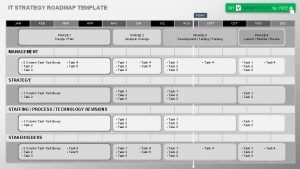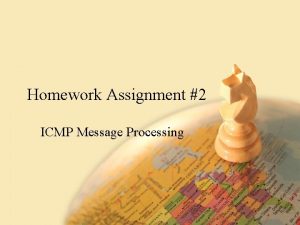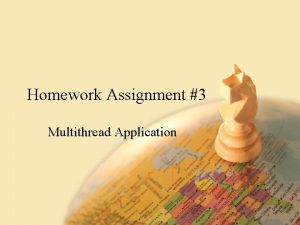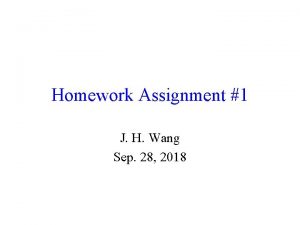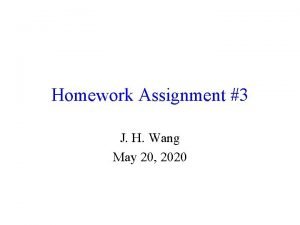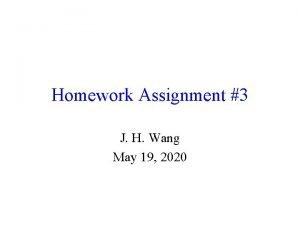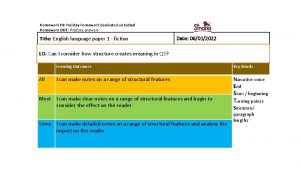Homework Assignment 2 J H Wang Apr 16




















- Slides: 20

Homework Assignment #2 J. H. Wang Apr. 16, 2020

Homework #2 • • Chap. 4: 4. 4, 4. 13 Chap. 5: 5. 8, 5. 15, 5. 19 Chap. 6: 6. 5, 6. 23 Programming exercises: • Programming problems: 4. 17*, 4. 21* • Programming problems: 6. 33* • Programming projects for Chap. 4* (*2) & Chap. 6* (*3) – Note: Each student must complete all programming problems and select at least one programming project for each chapter on your own • Due: two weeks (Apr. 30, 2020)

• Chap. 4 – 4. 4: Can a multithreaded solution using multiple user-level threads achieve better performance on a multiprocessor system than on a single-processor system? Explain.

– 4. 13: Consider a multicore system and a multithreaded program written using the many-tomany threading model. Let the number of user-level threads in the program be greater than the number of processing cores in the system. Discuss the performance implications of the following scenarios. – (a) The number of kernel threads allocated to the program is less than the number of processing cores. – (b) The number of kernel threads allocated to the program is equal to the number of processing cores. – (c) The number of kernel threads allocated to the program is greater than the number of processing cores.

– 4. 17*: An interesting way of calculating is to use a technique known as Monte Carlo, which involves randomization. This technique works as follows: Suppose you have a circle inscribed within a square, as shown in Figure 4. 18. (Assume that the radius of this circle is 1. )

– First, generate a series of random points as simple (x, y) coordinates. These points must fall within the Cartesian coordinates that bound the square. Of the total number of random points that are generated, some will occur within the circle. Next, estimate by performing the following calculation: =4*(number of points in circle)/(total number of points) (…to be continued)

(…continued from the previous slide) Write a multithreaded version of this algorithm that creates a separate thread to generate a number of random points. The thread will count the number of points that occur within the circle and store the result in a global variable. When this thread has exited, the parent thread will calculate and output the estimated value of .

– 4. 21*: The Fibonacci sequence is the series of numbers 0, 1, 1, 2, 3, 5, 8, …. Formally, it can be expressed as: fib 0=0 fib 1=1 fibn=fibn-1+fibn-2 Write a multithreaded program that generates the Fibonacci sequence using either the Java, Pthread, or Win 32 thread library. (… to be continued)

(… continued from the previous slide) This program should work as follows: On the command line, the user will enter the number of Fibonacci numbers that the program is to generate. The program will then create a separate thread that will generate the Fibonacci numbers, placing the sequence in data that can be shared by the threads (an array is probably the most convenient data structure). When the thread finishes execution, the parent thread will output the sequence generated by the child thread. Because the parent thread cannot begin outputting until the child finishes, the parent will have to wait for the child thread to finish.

• This program should work as follows: • On the command line, the user will enter the number of Fibonacci numbers that the program is to generate. • The program will then create a separate thread that will generate the Fibonacci numbers, placing the sequence in data that can be shared by the threads (an array is probably the most convenient data structure). • When the thread finishes execution, the parent thread will output the sequence generated by the child thread. • Because the parent thread cannot begin outputting until the child finishes, the parent will have to wait for the child thread to finish.

• Chap. 5: – 5. 8: The following processes are being scheduled using a preemptive round-robin scheduling algorithm. Each process is assigned a numerical priority, with a higher number indicating a higher relative priority. In addition to the processes listed below, the system also has an idle task (which consumes no CPU resources and is identified as Pidle). This task has priority 0 and is scheduled whenever the system has no other available processes to run. (… to be continued)

– The length of a time quantum is 10 units. If a process is preempted by a higher-priority process, the preempted process is placed at the end of the queue. Thread Priority Burst Arrival P 1 40 20 0 P 2 30 25 25 P 3 30 25 30 P 4 35 15 60 P 5 5 10 100 P 6 10 10 105 • (… to be continued)

– (a) Show the scheduling order of the processes using a Gantt chart. (b) What is the turnaround time for each process? (c) What is the waiting time for each process? (d) What is the CPU utilization rate?

– 5. 15: Explain the differences in how much the following scheduling algorithms discriminate in favor of short processes: (a) FCFS (b) RR (c) Multilevel feedback queues

– 5. 19: Assume that two tasks A and B are running on a Linux system. The nice values of A and B are -5 and +5, respectively. Using the CFS scheduler as a guide, describe how the respective values of vruntime vary between the two processes given each of the following scenarios: (a) Both A and B are CPU-bound. (b) A is I/O-bound, and B is CPU-bound. (c) A is CPU-bound, and B is I/O-bound.

• Chap. 6: – 6. 5: Explain why interrupts are not appropriate for implementing synchronization primitives in multiprocessor systems. – 6. 23: How does the signal() operation associated with monitors differ from the corresponding operation defined for semaphores?

– 6. 33*: Exercise 4. 17 asked you to design a multithreaded program that estimated pi using the Monte Carlo technique. In that exercise, you were asked to create a single thread that generated random points, storing the result in a global variable. Once that thread exited, the parent thread performed the calculation that estimated the value of pi. Modify that program so that you create several threads, each of which generates random points and determines if the points fall within the circle. Each thread will have to update the global count of all points that fall within the circle. Protect against race conditions on updates to the shared global variable by using mutex locks.

End-of-Chapter Programming Projects • Programming Projects for Chap. 4: (Choose one) – Project 1. Sudoku solution validator • To design a multithreaded application that determines whether the solution to a Sudoku puzzle is valid. • Passing parameters to each thread • Returning results to the parent thread – Project 2. Multithreaded sorting application • Write a multithreaded sorting program that works as follows: A list of integers is divided into two smaller lists of equal size. Two separate threads sort each sublist using a sorting algorithm of your choice. The two sublists are then merged by a third thread.

End-of-Chapter Programming Projects • Programming Projects for Chap. 6: (Choose one) – Project 1: The Sleeping Teaching Assistant • Room: 1 desk with a chair and computer • Hallway: 3 chairs • POSIX threads, mutex locks, and semaphores – Project 2: The Dining Philosophers Problem • Pthread mutex locks and condition variables – Project 3: Producer-Consumer Problem • Use standard counting semaphores for empty and full and a mutex lock, rather than a binary semaphore, to represent mutex. • Producer and consumer threads • Pthreads mutex locks/semaphores • Windows mutex locks/semaphores

Any Question or Comments?
 Jack prelutsky homework oh homework
Jack prelutsky homework oh homework Homework oh homework
Homework oh homework Alitteration definition
Alitteration definition Homework oh homework i hate you you stink
Homework oh homework i hate you you stink Literal language
Literal language Jack prelutsky homework oh homework
Jack prelutsky homework oh homework Weekly homework assignment sheet
Weekly homework assignment sheet Hungarian method
Hungarian method What does apr stand for
What does apr stand for àpr
àpr Apr air purifying respirator
Apr air purifying respirator Apr vs ear
Apr vs ear Sistem za centralizovano prijavljivanje korisnika apr
Sistem za centralizovano prijavljivanje korisnika apr Apr vs ear
Apr vs ear Ncaa apr database
Ncaa apr database Cours cap apr
Cours cap apr Apr vs ear
Apr vs ear Annual product report
Annual product report Jan, feb, mar
Jan, feb, mar Jin wang american born chinese
Jin wang american born chinese Zuoyue wang
Zuoyue wang


















